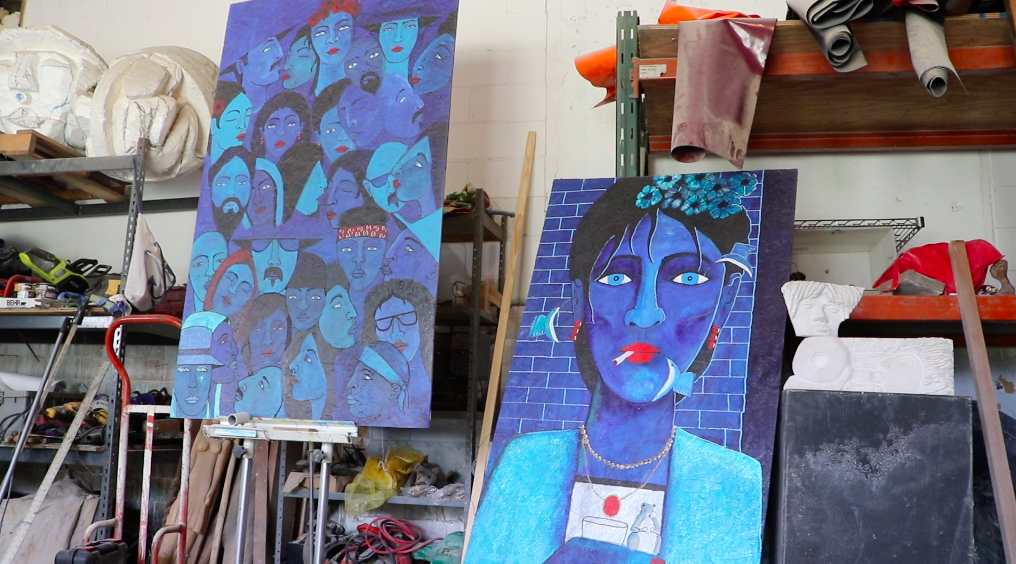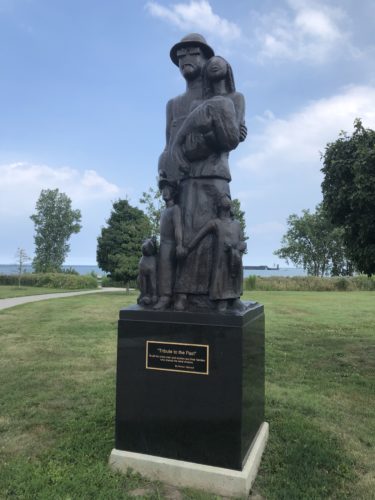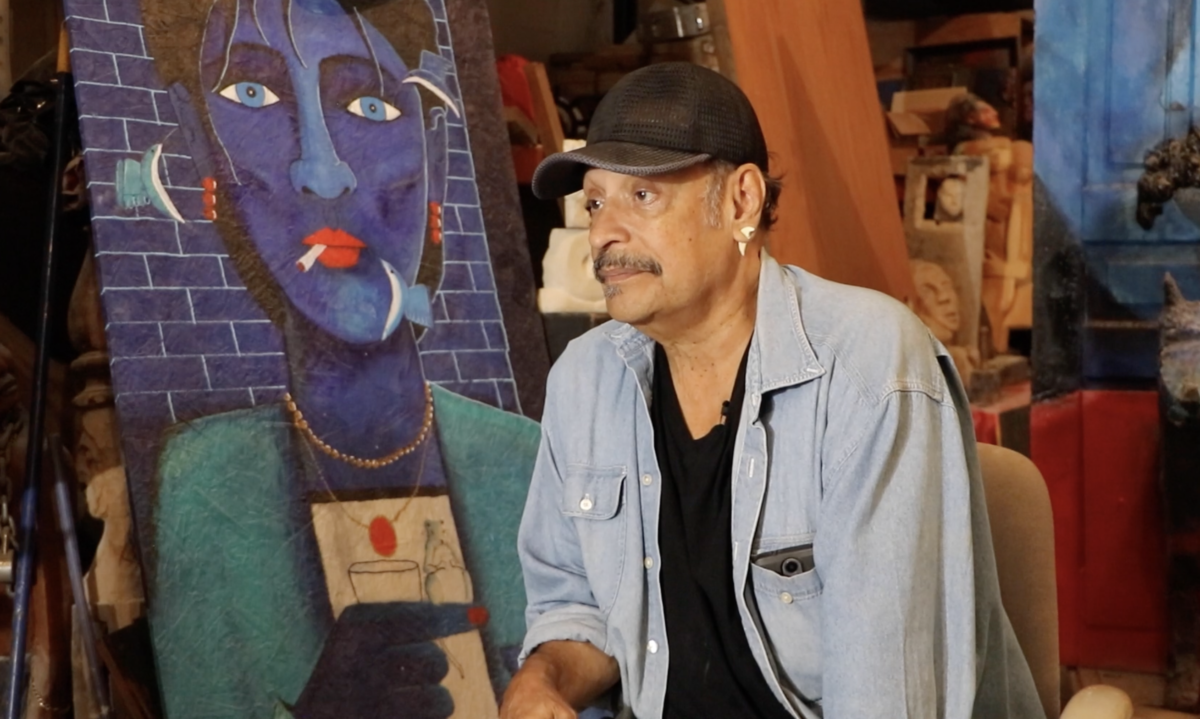The hammer and chisel are his main tools and South Chicago is his base. Sculptor and painter Roman Villarreal is the definition of an outsider artist. Homegrown and armed with a lifetime of experiences growing up in the far South Side, near the Indiana border, he likes to get dirty and will occasionally light up a joint in the studio. His working-class approach was usually “too much” for the highfalutin artworld.
In the 50s, Villarreal’s parents were doing farmwork in Michigan when they heard that there was a shortage of workers in the steel mills in Chicago. “So my father, his brothers, and a few other people that were all together came here and got hired on as laborers in the steel mill. But little did they know, they were strikebreakers,” he told the Weekly.
His father was hired and managed to put in thirty-something years that almost afforded the family a middle-class life. Villarreal remembers that South Chicago and East Side were racially and ethnically segregated, but there was a real sense of camaraderie among the children whose parents worked in the mills. They played outside everyday from dawn to dusk with minimal supervision.
Villarreal worked a “real” job for about a year before he was drafted into the military. That is where his political consciousness began to take shape. He began to think about his identity and where he fit in.
“It was through these brothers from California that I became a Chicano. It was an education on what was the big picture, because a lot of us didn’t even know there was a war going on, let alone the issues that were [affecting] our people in the Southwest, the farmworkers, because we didn’t even watch TV in those days,” he said.
The South Chicago neighborhood had the most Vietnam War casualties per capita in the United States and there is a permanent memorial at the historic Our Lady of Guadalupe Parish honoring these mostly Mexican-American men.
Back home there was too much going on to really listen to those soldiers who were returning home. With the mill salaries, working families had started to become homeowners, buying cars, and opening businesses. But suddenly, the mills were closing down and people’s lives were thrown into disarray. Almost overnight their property was being repossessed, Villarreal remembers.
The so-called bloody 90s is “when everything hit the fan, everything. I mean, the murder rate started going up,” he said. “But all these young men that were involved in that were all the men who were the children of the men who got displaced by the steel mills… When the mills closed, that’s when everything changed for everybody. Alcoholism, drugs, divorce, depression, all these things that were not there.”
He witnessed this community collapse through the lens of an artist. During these hard times, Villarreal decided he was going to take his fate into his own hands, for the sake of his children and family. “We were [nomadic], we used to work every single festival fair within a certain radius, every weekend we were working somewhere to make that extra money,” he said.
But he also suffered his own losses. He lost his younger brother to drug addiction, and he knew many guys who went to prison.
He quietly rationalizes it as a consequence of the times. “Very few choices were given to us at that time. So mistakes were made, we stepped into the black market, you know, the underground and all that. And bad enough, if you were an unemployed steel worker with minimal education, now to be an unemployed steel worker with a criminal record…”
An upcoming documentary by Steven Walsh potentially called “The Gray” will feature Villarreal and the stories of other residents coping with the end of the steel industry.
As a child, Villarreal loved to play with clay, and later on, he became proficient at working with other types of organic materials. There were other artists in the area who were of Mexican descent and influenced him, like muralists José González and Francisco and Vicente Mendoza—but not many sculptors. Years would pass before he met other sculptors who arrived from Mexico and out of state.
Villarreal went to art school only tangentially. He would sit in on his friends’ classes at the Art Institute and take what was useful to him. He believed that academia, at the time, repressed his creativity.

“That’s one thing about being an artist, there’s almost nothing you can’t work with. And that’s the beauty of being an outside artist, because a lot of techniques that you learn, they’re frowned upon in education. In other words, you don’t work with this material, you don’t mix this with this. They try to make you not use black… But when you’re an outside artist and learning, you use everything and anything until you figure out that this work, that don’t work, it’s trial and error,” he said.
The Southeast Side felt isolated from the rest of the city and Villarreal had to find ways to expose his work. There was a growing sense of solidarity among Latinx artists in the 70s that led to collaborations and friendships across neighborhoods, especially with and between artists from Pilsen. An art festival by the Museum of Science and Industry brought together many of these artists every fall.
Those relationships spawned early conversations with González about the idea to open a Chicano museum—it never materialized, but did lead to others developing the National Museum of Mexican Art, he said. Villarreal was among the artists who were featured in the museum’s first show. Afterward, however, he and some of his contemporaries went back to being “outside artists” and continued to pursue recognition. Most sought institutional recognition; Villarreal mostly wanted to connect with his community and make ends meet.

Perhaps his most public artwork is a bronze sculpture of a working family at the entrance of Steelworkers Park called “Tribute to the Past” unveiled in 2015.
“We grew up with the noise, the banging, the clanking of the steel. All our lives it was the noise of the steel mills. When they closed the mills and we had access to the park, it was the first time we ever went to the lake,” Villarreal previously told the Weekly. “We never realized how close we were to the lake all these years.”
Villarreal has worked with all kinds of stone. “My first medium, my passion, has always been stone. I’ve always enjoyed something about working hard and sweating as a part of life. You feel like you will accomplish a hard day’s work because we’re workers,” he said.
He’s used to working with limestone, which he calls an “urban stone,” and he’s not shy about scavenging for it in his own neighborhood, in empty lots and former industrial sites. He also works with a softer limestone from Texas, alabaster from Colorado, and feels honored to have worked with Italian serpentine, and his favorite, African serpentine.
But with the pandemic, many quarries have closed and sourcing the material has become expensive. He’ll sometimes use more affordable or less resistant minerals like antimony, and is always scouting for material in states as far as New York or California, though the shipping is costly.
A couple of years ago, the Intuit Museum, whose mission is to showcase outsider art, approached him about exhibiting his work. They visited his three studios and picked a few dozen artworks, mostly sculptures, to curate.
While they had to put the exhibition on pause during the worst of the pandemic, the show opened June 15 and is Villarreal’s first-ever retrospective show, which captures “the struggles and triumphs that followed the fall of the steel mill industry. He tackles complex subjects through creative experimentation and in a diversity of media,” said Alison Amick, chief curator at Intuit.
The museum will host other programming throughout the run of the exhibition, which closes January 8, 2023.
Jacqueline Serrato is the Weekly’s editor-in-chief.

